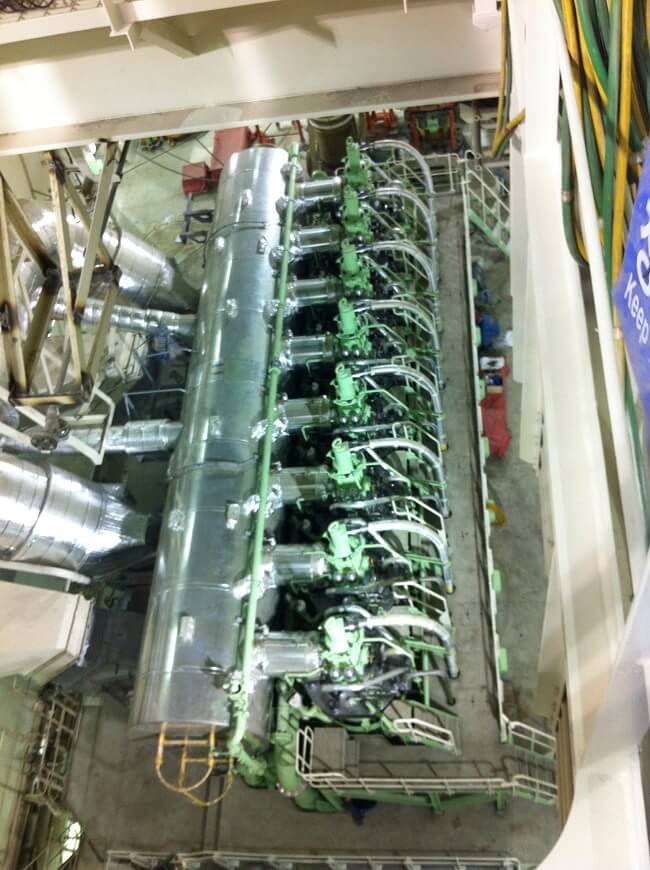How Marine Propulsion Engine of the Ship is Protected?
A ship’s propulsion engine is what keeps the ship going at sea. Considered as the heart of any vessel, the marine engine of the ship takes the entire load to propel the ship forward. Of course, without an engine a ship is almost a “dead ship.”
Throughout its life, the propulsion engine of the ship goes through various loads and stresses from rough weather to harsh manoeuvring and breakdowns.
To avoid any major loss or damage to the marine engine, several protective devices are fitted to safeguard the engine from major damages and breakdown.

Different Types of Protections on a Ship’s Marine Engine
Basically there are four main types of protection systems used to safeguard propulsion engine:
1. Alarm: In case of deviation of engine parameters from a set value, an audible and visual alarm will sound which will give an early warning of the problem.
2. Slow down: It is the next stage of protection when actions taken are not sufficient to control the ongoing problem; hence engine slow down is done to counter the disturbed parameter.
3. Shut down: When there is a higher fluctuation in the engine parameters which can harm other systems of the engine, the shut down protective devices cut off the fuel supply and the engine stops.
4. Starting Interlock: This will not allow the engine to start from the stand-still condition if some important system within the engine has not been operated or arranged properly.
Different Engine Slow Down Situations
In this situation the main engine will come to dead slow RPM i.e. below 30 RPM as the slow down protection gets activated. Following are different slow down situation for main engine:
- Lube oil pressure falls to 1.5 bar
- Cam shaft pressure falls below 2 bar
- There is no flow of piston cooling media (water or oil)
- Oil mist detector or Main bearing sensors has been activated
- Lube oil temperature at the inlet of engine is high > 60 deg C
- Piston Cooling temperature is high > 75 deg C
- Jacket water Temperature is high > 88 deg c
- Engine cylinder exhaust temperature is high > 450 deg C
- Scavenge air temperature is high > 65 deg C
- Thrust block temperature is high > 75 deg C
- Low flow of Cylinder lube oil
- Control air pressure is low < 5.5 bar
Different Shut down Situations
- Lube oil inlet pressure to engine is very low <1 bar
- Cam shaft Lube oil pressure is very low < 1.5 bar
- Very high Jacket cooling water temperature >95 deg C
- Low Jacket cooling water pressure < 0.1 bar
- No flow of Cylinder lube oil
- Thrust block temperature very high > 90 deg C
- Lube oil inlet pressure for turbocharger is low < 0.8 bar
- Over speed of the engine which activates shut down at 107 % of Max. continuous rating MCR
Different Starting Interlocks are
- Turning gear engage interlock
- Auxiliary blower off interlock
- Lube oil and other important pump not running interlock
Apart from safety protections on a ship’s engine, various other systems to ensure that various other operations are not affected.
Do you have info to share with us ? Suggest a correction
Subscribe To Our Newsletters
By subscribing, you agree to our Privacy Policy and may receive occasional deal communications; you can unsubscribe anytime.




great!
some engine scavenge pressue and governor interlock.
Dear Mohit,
Could you describe some ways to activate these alarms by simulating the situations which trigger above described slow down or shutdown of the ME?
Thanks!
Can interlocks be over ridden ? Such as lub oil pressure interlock ?
@ Sagar: Overriding an interlock (oil/water pressure) is possible for an emergency situation, where the engine can run as long as possible at reduced speed.
marine engine books a to z
One more slow down is misiing, Exhaust gas temperature devaition
@Rohit: Thank you for this important addition. ????????
Thank you for your good informations
Thank you for your comment Ali.
10q great man,Adersjew from Ethiopia
10q great man,Aderajew from Ethiopia